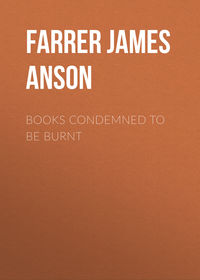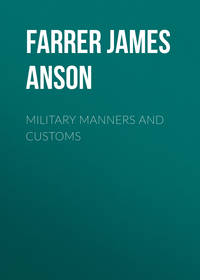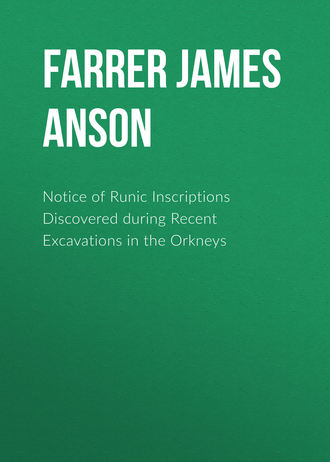
Notice of Runic Inscriptions Discovered during Recent Excavations in the Orkneys
The 6th and last line in No. xx. is —
Okonaekn Bar Fe Ur haugi thessumOkonaekn bore money out of (away from) this tumulusIt seems, then, that it was supposed to have been originally erected for a mighty woman called Lodbrok, who had gallant sons, and that the Jerusalem pilgrims had dug into the Orkhill, which was probably a different place to this Maes-Howe, that the treasure contained there had been taken away, and that he would be lucky who found it. It also implies that Okonaekn carried off some of the treasure. – Professor Munch.
Nos. XIX. and XXSia Höuhr, Var Fyr Lathin Haelr Lothbrokar
Syner Haenar Thaeir Vöro Hvatir Slikt Vöro
Maen Saem Thaeir Vöro Fyri Sir
Iorsalafarar Brutu Orkhöuh Lifmnd
Sailia Iarls Ut Northr Ir Fe Folhit Mikit
That Urlofoir Hir Var Fi Folhget Mikit
Raeist Simon Sihr in Tho Ingi Sihrith
Saelir Sa Ir Fina Ma Than Outh Hin
Mikla. Ogdonaegn Bar Fi yr
Ouhi Thisum.
This barrow was formerly a sorcery hall, erected for Lodbrok; her sons were brave, such were men as they were for themselves (such we may call valiant men, such as they were in their achievements).
The Iorsalafarar (visitors of Jerusalem) broke open Orkhow.. Earls.
To the north-west a great treasure has been hid (but few believe that), a great treasure was hid here. 5 Simon sigr (victor) carved (the Runes) and afterwards Inge.
Happy he who may discover this great wealth. Ogdonaegn carried away the goods from this barrow.
Ogdonagn is probably a Gaelic name, perhaps corresponding to the present O’Donavan, and the person alluded to may have been of Scottish or Irish origin. – Professor Rafn.
Plate XI.
No. XXIArnfithr, Raeist, Runar, Thisar, Sonr StainsArnfith risted Runes there, the son of Stain. Thruki LetThe beginning of an unfinished formula. – Professor Stephens.
Arnfithr, Raeist Runar Thisar Sorn Staeins Thrukr LitArnfinn the son of Steins engraved these RunesThe other letters are defective and give no distinct meaning. – Professor Munch.
Arnfithr Raeist Runar Thisar Sonr StainsThrukr Lit Arnfinn, a son of Steins, carved these runes. Thrud caused.. (incomplete). – ProfessorRafnNo. XXIIBot Ær Oktil at Sokua, Suo in Kotalant.6 Sua Inklant.Boot (blood money) is also to seek, so in Gothland, so in EnglandIt may also be a fanciful Alphabet. – Professor Stephens.
There are peculiar Runes, but too obscure for interpretation. Similar ones have been found near Baffins Bay. (Vide Antiquitates Americanæ). – Professor Munch.
This No. represents some signs belonging to the calendar – similar ones have been found in the Paradise cavern, and at Hof in Iceland. (Vide Rafn. Antiquitates Americanæ). – Professor Rafn.
No. XXIIIIkikaethir, Kynana, In, UaenstaInkikaethr, of women the fairestAlso the figure of an Otter with a fish in its mouth, meant for a decoration. – Professor Stephens.
Ikikaerth Ir Kynana in Uaensta Ingigerthr is of women the most beautiful.– Professor MunchIgigaerth Ir Kynana In Vaensta Ingigerth is the fairest of the women.– Professor RafnPlate XII.
No. XXIVNo interpretation of this is offered by the learned Professors.
Nos. XXV. and XXVIA Dragon and Worm Knot. – Professor Stephens.
No. XXVThis is a Dragon drawn with art. There is a similar one on a stone at Hunstead in Scania. It may be ascribed to the heathen times, as well as the construction of the barrow itself. – Professor Rafn.
No. XXVIA serpentine winding like those found on Runic stones in the Scandinavian north and on other monuments from the last period of heathenism, and the commencement of the Christian era. – Professor Rafn.
Plate XIII.
The remaining Nos. are considered by all the learned Professors as “scribbles” or scratches, and must be considered as unimportant.
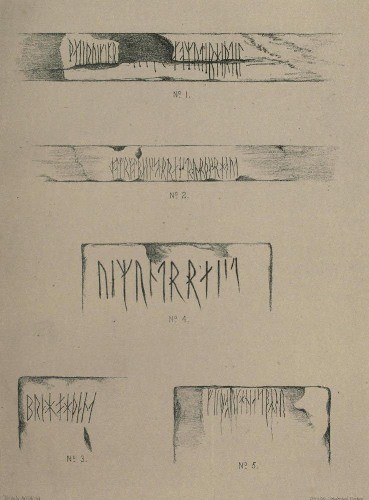
Plate VII.
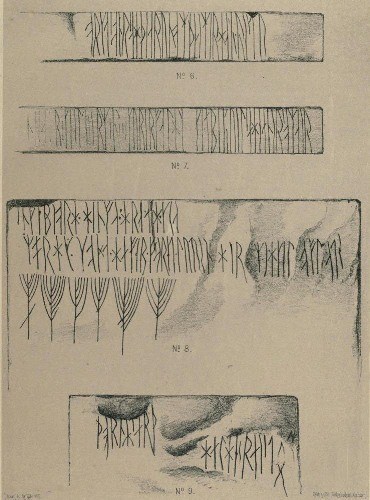
Plate VIII.

Plate IX.
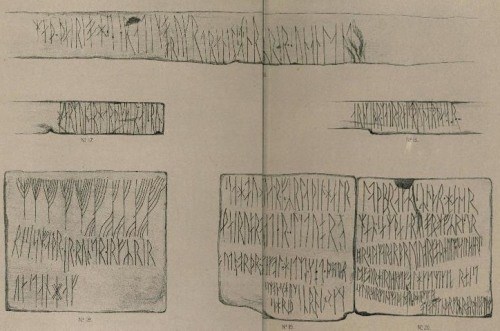
Plate X.

Plate XI.
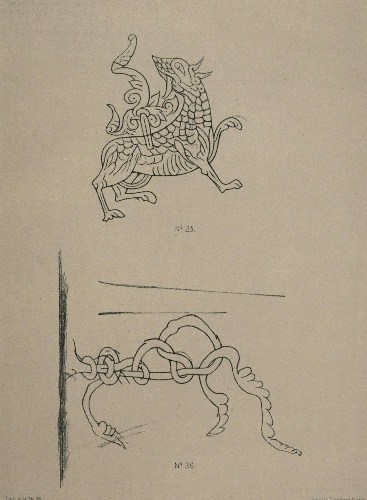
Plate XII.
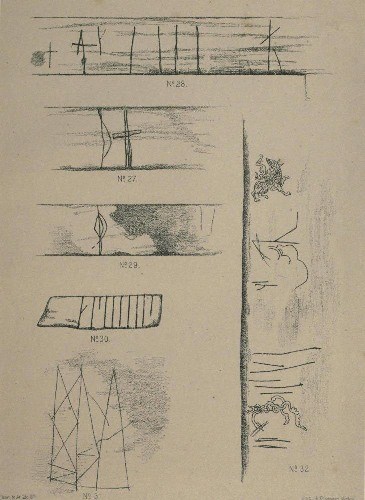
Plate XIII.
1
The country people state that the building was formerly inhabited by a person named Hogboy, possessing great strength. Haugbuie, in Norse, signifies “the ghost of the tomb;” and Haugr, “tumulus.”
2
Professor Rafn says Lothbrok – a pair of shaggy trousers – was the well-known surname of Ragnar Lodbrok. At the time of the carving of the inscription, a popular tradition current in the Orkneys may have ascribed to far antiquity, and to the said hero of the mythico-historical times, the construction of the barrow; and on account of the want of historical knowledge, since the word lothbrok is of feminine gender, the hero may have been mistaken for a woman, and besides, the accounts in the sagas of his sons may have been repeated, that they were brave and valiant. The account given in the Fridthiofs Saga of the Earl Angantyre, reminds us of the pre-historic times of the Orkneys (vide Tridthjóss Saga, c. 5. Thorsteins Saga Vikings). Here a popular tale preserved to us in Runes, does the same by telling us that this barrow was the sorcery platform erected of old for the use of Lodbrok, and was probably also a temple and place of worship.
3
The word read by Professor Rafn, Maur, instead of Mar, and considered as a proper name, is read mair or more by Professor Stephens. In the engraving No. 7, the letters are

4
Professor Munch supposes that the Jerusalem travellers, who are described in No. 13 as having broken into the how, were connected with an expedition organized by Earl Ragnvald to the Holy Land. He says “many of the northern warriors joined the Earl in 1152. They assembled in Orkney, and after passing the winter there, sailed in the spring of 1153, and after being in Spain in December of that year, reached the Holy Land in August 1154; they went thence to Constantinople, where they passed the Christmas of 1154-55, returning home by different routes. During their stay in Orkney they had frequent quarrels with the inhabitants.” As some of the inscriptions seem to indicate the existence of treasure in the tumulus, it is not unlikely that it should have been examined by these warriors, and that they afterwards inscribed their names, together with other remarks, on the walls.
5
There is a similar allusion to hid treasure on the wall of a rock at Berrig, in the Star valley North Throndheim County – “gull faitu nin alna nither” – They hid some gold nine ells deep in the earth.
6
This (“evidently very difficult carving,” says Professor Stephens) may be taken as a fair specimen of the Bind-rune form of writing.
“The first letter is B, a very rare form; the second an ornamental O, with three side strokes instead of two; the third a T, the strokes being reversed and repeated above and below; the fourth


























